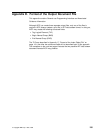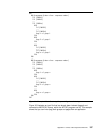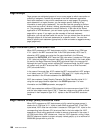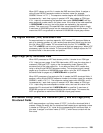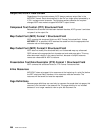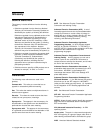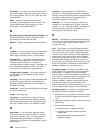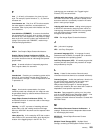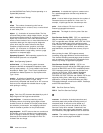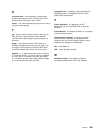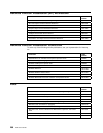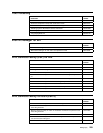F
font. (1) A family of characters of a given size and
style. For example, 9-point Helvetica. (T) (2) See font
character set.
font character set. Part of an AFP font that contains
the raster patterns, identifiers, and descriptions of
characters. Often synonymous with character set. See
also coded-font.
form definition (FORMDEF). A resource that defines
the characteristics of the form which include: overlays to
be used (if any), text suppression, and position of page
data on the form, and the number and modifications of
a page. Synonymous with FORMDEF, medium map.
Contrast with page definition.
G
GOCA. See Graphic Object Content Architecture.
Graphic Object Content Architecture (GOCA). An
architecture that provides a collection of graphics values
and control structures used to interchange and present
graphics data.
group. A named collection of sequential pages that
form a logical subset of a document.
H
hexadecimal. Pertaining to a numbering system with a
base of 16; valid numbers use the digits 0 through 9
and characters A through F, where A represents 10 and
F represents 15.
I
image. An electronic representation of a picture
formed by toned and untoned pels. An image can also
be generated directly by software without reference to
an existing picture.
Image Object Content Architecture (IOCA). An
architected collection of constructs used to interchange
and present images.
indexing. In ACIF, a process of matching reference
points within a file and creating structured field tags
within the MO:DCA-P document and the separate index
object file.
index object file. A file created by ACIF that contains
Index Element (IEL) structured fields, which identify the
location of the tagged groups in the AFP file. The
indexing tags are contained in the Tagged Logical
Element (TLE) structured fields.
indexing with data values. Adding indexing tags to a
MO:DCA-P document using data that is already in the
document and that is consistently located in the same
place in each group of pages.
indexing with literal values. Adding indexing tags to
a MO:DCA-P document by assigning literal values as
indexing tags, because the document is not organized
such that common data is located consistently
throughout the document.
IOCA. See Image Object Content Architecture
J
JCL. job control language.
JES. Job Entry Subsystem.
job control language (JCL). A language of control
statements used to identify a computer job or describe
its requirements to the operating system.
Job Entry Subsystem (JES). A licensed program that
receives jobs into the system and processes all output
data produced by the jobs.
L
library. A data file that contains files and control
information that allows them to be accessed individually.
licensed program. A utility that performs a function for
the user and usually interacts with and relies upon
system control programming or some other
IBM-provided control program. A licensed program
contains logic related to the user's data and is usable or
adaptable to meet specific requirements.
line data. Data prepared for printing on a line printer
such as an IBM 3800 Printing Subsystem Model 1. Line
data is usually characterized by carriage control
characters and table reference characters. Contrast with
MO:DCA-P data.
M
Mixed Object Document Content Architecture. A
strategic, architected, device-independent data stream
for interchanging documents.
MO:DCA-P. Mixed Object Document Content
Architecture
Multiple Virtual Storage (MVS). Multiple Virtual
Storage, consisting of MVS/System Product Version 1
Glossary 203



